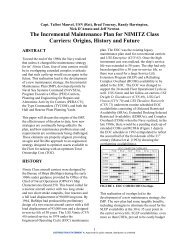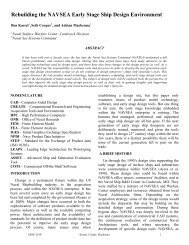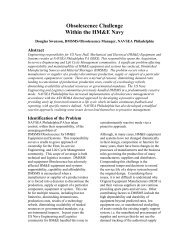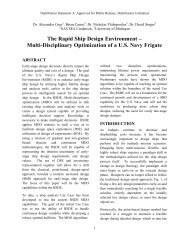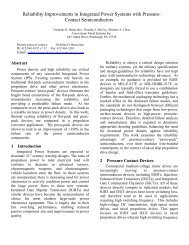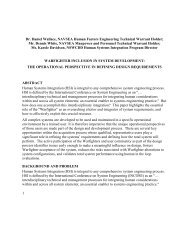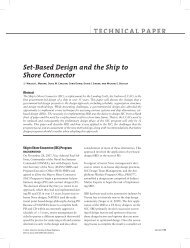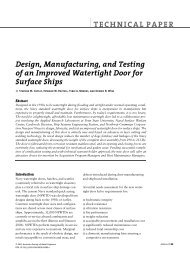The Wreck of DKM Bismarck − A Marine Forensics Analysis 1 The ...
The Wreck of DKM Bismarck − A Marine Forensics Analysis 1 The ...
The Wreck of DKM Bismarck − A Marine Forensics Analysis 1 The ...
Create successful ePaper yourself
Turn your PDF publications into a flip-book with our unique Google optimized e-Paper software.
<strong>The</strong> <strong>Wreck</strong> <strong>of</strong> <strong>DKM</strong> <strong>Bismarck</strong> <strong>−</strong> A <strong>Marine</strong> <strong>Forensics</strong> <strong>Analysis</strong><br />
through the torpedo bulkhead would have contributed to sinking the <strong>Bismarck</strong>. This is an<br />
important distinction. It is also important to note that a 356-mm shell fired at long range from<br />
Prince <strong>of</strong> Wales, falling short and striking below the main side belt, was able to damage the<br />
torpedo bulkhead enough to cause flooding beyond the side protective system.<br />
Each <strong>of</strong> the six 150-mm secondary turrets aboard <strong>Bismarck</strong> has been observed to have<br />
sustained at least one direct hit, mostly achieved by the 134- and 152-mm batteries on the<br />
battleships and the 203-mm guns on the heavy cruisers. We believe these hits were the results <strong>of</strong><br />
the random dispersion <strong>of</strong> salvo fire, with accurate fire inhibited by the Sea State Six conditions<br />
and the heat <strong>of</strong> battle. This was certainly be the case on the starboard side, where Norfolk and<br />
Dorsetshire expended 781 203-mm shells.<br />
<strong>The</strong> British gunnery accuracy was mediocre at best. This certainly drew the attention <strong>of</strong><br />
Admiral Tovey aboard King George V, when he noticed at 0930 that <strong>Bismarck</strong> was still afloat<br />
despite the pounding she was taking. He told CAPT Patterson, “Get closer; I do not see enough<br />
hits.” Some 2,000 medium-caliber shells were fired and only about 10% <strong>of</strong> them hit <strong>Bismarck</strong> (a<br />
large, barely moving target usually only a few miles away,)<br />
During the morning battle <strong>of</strong> 24 May, the Prince <strong>of</strong> Wales’ gunnery had been rather<br />
effective, despite the fact that the battleship’s turret crews were very inexperienced 32 . <strong>The</strong> Prince<br />
<strong>of</strong> Wales had been in service only three weeks before being dispatched to fight <strong>Bismarck</strong>. Her<br />
356-mm shell hits were achieved during a very short engagement. Two <strong>of</strong> these hits changed<br />
history, causing <strong>Bismarck</strong> to slow down with a bow-down trim. This damage allowed Victorious<br />
to get within range to make her air attack later in the day. Later in the day, Admiral Lütjens<br />
changed his plans, turning <strong>Bismarck</strong> to head for France for battle damage repairs. Days later,<br />
<strong>Bismarck</strong> would encounter aircraft with more experienced aviators launched by Ark Royal.<br />
Prince <strong>of</strong> Wales and King George V each had ten 356-mm guns that fired shells weighing<br />
721 kilograms. Hood had eight 381-mm guns firing shells weighing 879 kilograms. <strong>The</strong> Rodney,<br />
was armed with the largest guns in the Royal Navy, nine 406-mm guns that could fire 929kilogram<br />
shells. <strong>The</strong> heavy cruisers Norfolk and Dorsetshire were armed with 203-mm guns that<br />
fired a 116-kilogram shell. <strong>The</strong> cruiser guns were vastly inferior in power to the 406-mm guns,<br />
with their shells having a kinetic energy only about 15 per cent <strong>of</strong> that <strong>of</strong> the larger shells. <strong>The</strong><br />
burster charges <strong>of</strong> the two shells differed similarly.<br />
<strong>The</strong> inevitable sinking process was accelerated by the detonation <strong>of</strong> scuttling charges by<br />
the Germans. (This is our conviction, albeit a mildly controversial one for those who insist that<br />
there was no scuttling <strong>of</strong> the German battleship. Certainly, <strong>Bismarck</strong> would have sunk even if not<br />
scuttled by her crew. 33 )<br />
TORPEDO DAMAGE DURING THE FINAL BATTLE<br />
Two large sections <strong>of</strong> the lower side and bottom shell structure below the armor belt on<br />
the starboard are missing from the main hull. Unique hydraulic outburst phenomena, described<br />
later in this paper, separated this plating from the ship on impact with the sea bed. <strong>The</strong> aft end <strong>of</strong><br />
one long hole created by hydraulic outburst, on the starboard side aft, shows evidence <strong>of</strong><br />
probable torpedo damage. It is unclear if the torpedo may have weakened the shell structure and<br />
contributed to the outburst effect, <strong>of</strong> if the effect occurred without prior weakening, and was in<br />
32 Prince <strong>of</strong> Wales was completed on 31 March 1941, less than two months before her engagement with<br />
<strong>Bismarck</strong>. <strong>The</strong> German battleship was completed on 24 August 1940.<br />
33 <strong>Bismarck</strong> had prize crew personnel with associated scuttling charge equipment on board.<br />
32



